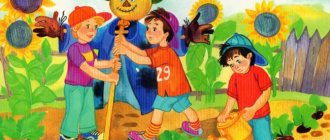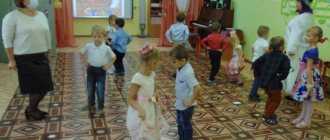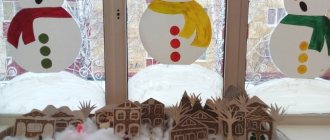Music lesson in the preparatory group “Listening to Music”
Introductory part
Topic: Listening to music. The visual nature of music.
Tasks:
- Introduce children to instrumental pieces.
- Learn to identify the two-part form of music.
- Strengthen the ability to convey the character of the work through movements.
Progress of the lesson
To the sound of marching music, children enter the hall, then perform exercises that reinforce expressive movement skills (springing, twirling, stamping with two feet) in pairs.
The music director sings: Hello, children! Answer: Hello!
Musical director: We’ll sit down, sit, and look at the pictures! (Pictures depicting sparrows and cars are attached to the magnetic board)
Musical director: Now let’s close our eyes, open our ears, listen carefully, imagine diligently!
(Listening to G. Fried’s musical work “Sparrows and the Car”)
Musical director:
- Guys, what is the character of our music?
- Who does the music sound like?
Look at the pictures and choose the one you need.
Now listen to the music again and show the desired picture that matches the first part of the piece and the desired picture that fits the second part of the piece. (children listen and show)
Musical director: What can you call our music? Children's answer...
Musical director: Now we’ll see how you can transform. When the first part sounds, you will depict the image of small birds in your movements, in the second part - the image of cars. (Children perform the appropriate movements) The music director praises the children.
Musical director: Now let’s remember what the nature of the play “Butterfly” is, which we listened to in the last lesson? Children's answer...
Musical director: Now tell me, is our music similar to the play “Butterfly”? Children's answer...
Also an interesting musical activity: GCD for musical activities (listening to music). Topic: Antoshka.
The game "Butterflies" is being played
Fake flowers the size of children are displayed (cornflower - blue, chamomile - white, dandelion - yellow, poppy - red), butterflies fly around the clearing to the song, to the words:
- Butterflies flew to a cornflower flower, a blue flower (the music stops, the butterflies gather in a circle around the desired flower, in this case it is a cornflower. The song about butterflies sounds again, with lyrics...);
- I met a daisy, cutie butterflies, a daisy flower, a white petal (the music stops, the butterflies gather around the desired flower, a daisy);
- The butterflies flew in and sat on the dandelion, the dandelion is the sun, the golden bottom (the music stops, the butterflies gather around the dandelion flower);
- The butterflies were flying, and they recognized the flower, it’s a red poppy - my friend, it’s like a festive flag (the music stops, the butterflies gather around the flower - a dandelion).
Musical director: Butterflies flew to the clearing and heard wonderful sounds.
"Spring Song" sounds.
Musical director: A song was played that conveys the spring mood and is similar in character to our sparrows and butterflies.
Repeat after me the words of this funny song:
The gentle sun, the sun of spring, The sun woke up a leaf from winter And the field woke up, and the forest woke up And under the warm sun, many miracles. (learning the first verse)
Musical director: And now, to light, graceful music, let’s try to express the spring mood in free dancing. (Children depict thawed butterflies, blades of grass growing and stretching upward, flying birds, awakened bear cubs, cheerful bunnies, the shining sun...)
Musical farewell: Goodbye children. Children: Bye to you.
Author: Kireeva Svetlana Borisovna Position: music director Place of work: MBDOU No. 299 Location: Krasnoyarsk
Notes on the perception of music in a preschool preschool group
Abstract of the NOD on the perception of music in a preschool group of preschool age - “The Lark” by P. I. Tchaikovsky
Author: Ekaterina Valerievna Shvab, music director of the MBDOU Loukhsky kindergarten, Louhi village, Loukhsky district, Republic of Karelia Description: The abstract may be of interest to music directors, preschool teachers, music teachers of secondary schools Goal: Expanding children's knowledge about the music of P.I. Tchaikovsky, enriching knowledge about the behavior of birds in the spring. Objectives: -Expand and clarify ideas about the three-part form of P.I.’s works. Tchaikovsky -Develop memory, attention, logic, thinking; Based on your own experience, highlight the main thing, compare, draw conclusions. -To instill in children a love and respect for nature. Attributes: On the stand is a portrait of the composer P. I. Tchaikovsky, an illustration of the work “The Lark”, an illustration of a spring forest with an image of a lark, cards of the components of this work (3-part form) - 2 orange cards and 1 blue card. Video recording “The Lark's Song” -Educational channel for listening to preschool children (preparatory group) Procedure: Musical director: Please look at the stand, what is the name of this composer? Children answer: Pyotr Ilyich Tchaikovsky Musical director: Today we will get acquainted with a new work by P.I. Tchaikovsky, which is called “Lark” Musical director: Please tell me what you know about larks, who are they? Children answer - Birds. Musical director: When do they arrive to us? Children : In the spring Musical director: Why do you think the birds sing in the spring? Children answer: They rejoice in spring, rejoice in the warmth, the sun... Musical director: But no! Spring song for birds is a very important and serious matter. And, by the way, only males sing.
The little warbler returns home in the spring and immediately declares at the top of his voice: “I have arrived! This is my site, my territory! This is where I will live, hunt and raise my chicks.” With its song, a bird establishes the boundary of its territory; it is invisible. But it is audible.
If the voice of a rival appears nearby, the owner of the site rushes and drives him away from his territory. But birds of other species are allowed to settle in, because such neighbors have different food and nesting material. There is nothing to argue with them about. Just imagine, the future father has found a place for a nest and begins to call the mother of his future chicks with a ringing song. The future bird mother will hear one song, a second, a third, and will choose the most beautiful one and fly in. Let's now listen to how the lark sings in the spring. Pyotr Ilyich Tchaikovsky in this work spoke only about one bird, as he heard it. A lark flutters over the field, the cornflowers turn blue in the rye, and the sun laughs cheerfully in the transparent mirror of the river. Silenced everyone. A perky voice rings throughout the entire forest. (Berezhnaya S.) The musical director plays the first part of the play “Lark”. Then stops recording. Tell me, what song sounded like it now? Children answer: Sounding, joyful, cheerful. Musical director: Let's listen further to how the bird sings. (Starts the second part of the play, then stops at the end of the second part) . Musical director: And now, as the lark sang, has anything changed in the character of his song? Children answer: The song has become sad, sad. Musical director: Why do you think the lark became sad? Children offer their own options. The musical director adds: Or maybe the sun has stopped shining or the future mother of his chicks has not yet flown to him, but he tried so hard to sing... Let's listen to the last part of the lark's song . (includes the third part of the work) Musical director: What can you say about this song of the lark? The children answer: The song became joyful, cheerful, and confident again. Musical director: And now what was the lark singing about? Children offer their own answers. The music director adds: “He probably saw his female friend flying towards him, he was very happy and sang very piercingly and tenderly. “I’m here, I’m very happy! Fly to me!!"
The music director points to the first orange card: Now let’s remember once again what the nature of the song was in the first part of P.I. Tchaikovsky? Children answer: Joyful, cheerful Musical director: (points to the second blue card): And what was the character of the second part of the music? Children: Sad, sad... Musical director (points to the third orange card): And in the final part of the music, what was the lark's song again? Children: Joyful, cheerful, gentle... Musical director: How many sad songs did the lark sing? Children: One Musical director: How many joyful songs did you sing Children: Two Musical director: Please tell me how many parts there were in P.I.’s work. Tchaikovsky's "Song of the Lark"? Children: Three Musical director: Did you like the story about the lark? And his song? Children answer Musical director: Well done, you studied very well today, thought diligently, answered questions and learned a lot about larks in the spring. We know a lot about birds and at the same time little, and everyone needs: both you and us, so that there are more of them. In winter, put out a feeder for them, Give the tits some lard; All sparrows eat millet, add more as soon as it becomes scarce. They will reward your labors, And the gardens will bloom all around. Among those green foliage you will hear their song. (Pupils of grade 2 B of school No. 16 with in-depth study of individual subjects in the city of Zhigulevsk) a Literature:
“Music classes in kindergarten” Z.N. Bugaeva Publishing House AST; Stalker, Moscow 2005
We recommend watching:
Summary of a music lesson in the preparatory group Musical and creative game for older preschoolers “Silver Snowflake” Summary of an integrated lesson in the preparatory group of a kindergarten Musical lesson in the preparatory group of a kindergarten
Similar articles:
Summary of a music lesson in a preparatory group on the topic: Autumn
Summary of a thematic music lesson for children 6-7 years old
Scenario of a musical literary composition based on a fairy tale by J. Rodari for children of the preparatory group
Scenario for a musical evening of entertainment in kindergarten for older children
Summary of the music lesson "listening to music" for children in the preparatory group
01/16/17 (preparatory)
Training tasks :
- Repetition of the covered material “ditties”
- Studying the new song “Russian Army”
- Listening to music (character of music: production, fast, slow)
- Developmental tasks:
- develop emotional responsiveness,
- form a singing voice.
- Educational tasks:
- cultivate love and interest in music;
Musical material for the lesson
Song “Russian Army” lyrics by N. Naidenova, V.V. Skurlatova
"Ditties"
Listening to music by Edvard Grieg "morning"
One of the musicians whose work “Morning” we will listen to today is the Norwegian composer Edvard Grieg. (Small biographical information about the composer, prepared by 2-3 students.)
— Grig liked to walk through the forest in the morning. And then one day, while walking, he met a girl. The little girl was so pretty and cheerful that Grieg wanted to give her something, but he had nothing with him. And then he decided to give her music. - So, let's close our eyes and try to imagine the awakening of nature, which the composer depicted with the help of music. (Initial listening.)
— What did you imagine while listening to this work?
(Children's answers.)
Secondary listening to the work with the teacher’s comments, which complement and clarify the students’ answers:
— Imagine that everything in nature is asleep. ( Music starts playing.
) The forest is sleeping, the river is sleeping, a thin stream is quietly babbling between the pebbles, as if it is afraid to break the silence.
Little green leaves have little green dreams. Animals and birds are sleeping. In the hollow of an old tree, a mother squirrel has covered the baby squirrels with her fluffy tail and is sleeping comfortably. ( The music is quiet.
)
- And the sky is blue-blue.
- The stars are big, bright, there is a full moon in the sky, and there is a lunar path on the river from it. And then on the horizon, where it seems that the sky meets the earth, a light strip appeared. It grows, expands, and the stars begin to fade and fade away one after another. The dawn is breaking in the east, and the water appears pink. The sun rises above the earth to the singing of countless birds. The spider web stretched out in the forest sparkles with a multitude of sparkles ( The music sounds louder.
)
“And then, behind the trunks of the old linden trees, a huge flaming ball will rise above the ground. It grows, shines with a joyful light, plays, smiles.
— A new day begins.
- What event is this? (Joyful, bright, kind, interesting).
— With what sounds, intonations, shades did Grieg express the awakening of nature? (Light, calm, melodic, affectionate, magical, wonderful, exciting, friendly, cheerful, enchanting, majestic, etc.)
M.R. Well done boys! Right
There are a lot of mountains in Norway, where the composer Edvard Grieg lived. And gnomes live in the mountains. And these are the gnomes the composer depicted in his music. Let's listen to this piece.
Listening: "Procession of the Dwarves"
What kind of gnomes do you think are told about in E. Grieg’s play “Procession of Dwarves”, good or evil? (The play is played in the recording.)
Children. About the evil ones.
M.R.
Why do you think so?
Children. The music is mysterious, sometimes scary, evil.
M, R
What is the middle part of the play like, what is its mood? (A fragment plays.)
Children. The music is magical and gentle.
M.R.
Maybe the composer wanted to depict how the treasures of the gnomes sparkle, their fabulous riches, which are stored in the dungeon?
The music sounds light, enchanted, as if the gnomes, holding their breath, admire their riches and jewelry, examining them. Then the treasures of the gnomes are depicted. The music begins to flicker, sparkle, sparkle, sparkle and shimmer.
Discuss what you heard with the children, what color they think expresses this music.
M.r.
There are a lot of mountains in Norway. We will now find ourselves in the cave of one of them. And the owner of the cave, the mountain king, will meet us.
Who can you imagine?
So, we found ourselves in the underground kingdom of the Dovr grandfather - the mountain king. In the throne room of his palace, court trolls, gnomes, foresters, and brownies gather. They want to celebrate their princess's wedding to Per.
- Listen and determine what is special about the work?
Secondary hearing
What does the melody sound like? (Warry, mysterious) Is she changing? (repeats constantly)
What is changing? (the tempo gradually accelerates, the dynamics become gradually louder)
— What picture does a change in tempo and dynamics paint in music? What can you imagine? (the movement speeds up and the music turns into some kind of crazy whirlwind)
— What genre is the basis of the work? (march)
M.R
- Well done boys!
M.R.
Guys, who can tell me what songs we sang today?
Which composer did we meet?
What kind of music did you listen to? What is it called?
What did you like most?
Well done guys, our lesson has come to an end. Let's say goodbye to you
Goodbye.
Memo to the teacher: for the next music lesson, children should not forget the words of the songs they have learned. It is advisable to talk through them with the children 2 times in a group.








